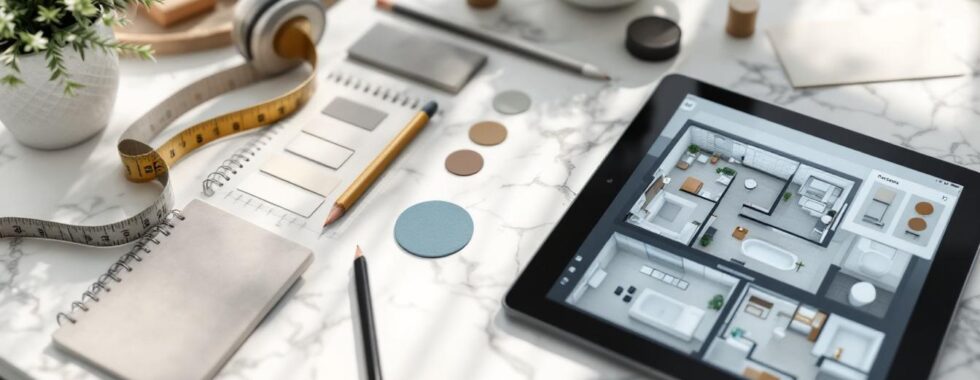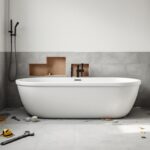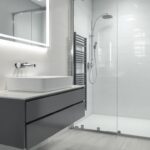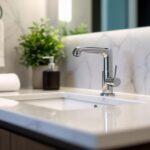How to Create a Bathroom Remodel Planner
At Cameron Construction, we know that a well-planned bathroom remodel can transform your space and boost your home’s value.
Creating a comprehensive bathroom remodel planner is the first step towards achieving your dream bathroom.
This guide will walk you through the essential elements of planning your renovation, from assessing your current space to designing your ideal bathroom and budgeting for success.
What’s Your Bathroom’s Current State?
Spotting the Flaws
Take a critical look at your existing bathroom. Spend time in the space and note everything that bothers you. Is the layout awkward? Does the shower feel cramped? Do you bump into things? Make a list of all these issues. Don’t hold back – even small annoyances can become major frustrations over time.
Check for signs of water damage, mold, or mildew. These problems often hide in corners or under fixtures and can significantly impact your remodel plans. The Environmental Protection Agency reports that one third to one half of all structures have damp conditions that may encourage the development of pollutants such as molds and bacteria. Address these issues early to avoid future headaches.
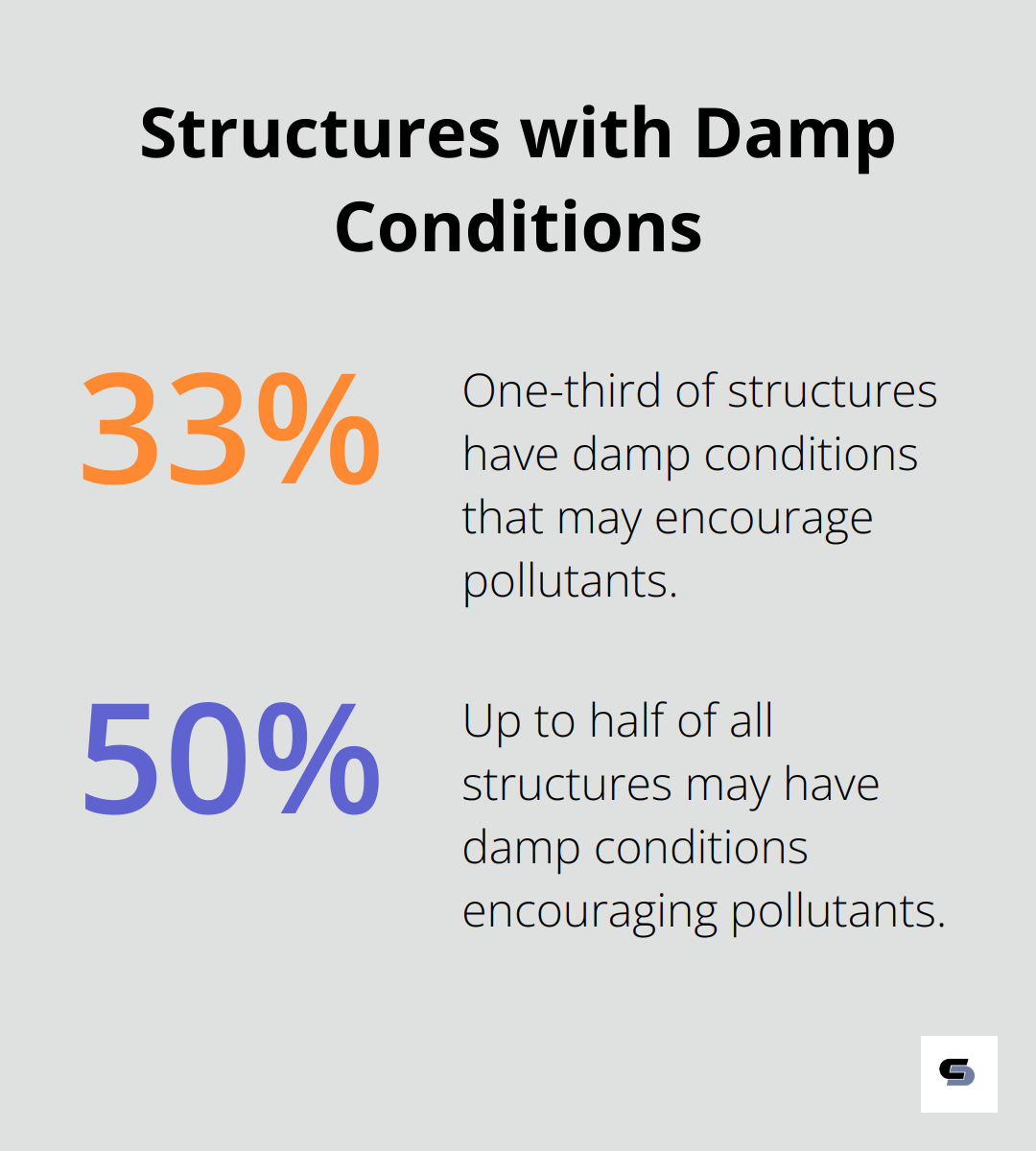
Measuring for Success
Accurate measurements form the foundation of any successful bathroom remodel. Don’t rely on guesswork or old blueprints. Use a tape measure and document every dimension of your bathroom. Measure the overall length and width, but also note the location of windows, doors, and existing plumbing fixtures.
Pay special attention to the “wet wall” (the wall that houses your plumbing). Moving this wall can significantly increase your remodel costs, so know its exact location. The National Kitchen and Bath Association suggests leaving at least 30 inches of clear space in front of fixtures for comfortable use.
Dreaming Big (Within Reason)
While assessing your current bathroom, think about your dream features. Do you want a luxurious soaking tub? A double vanity? A walk-in shower? Write these ideas down, but keep your space constraints in mind.
Most homeowners spend around $12,120 on bathroom remodeling. A clear understanding of your current space and desired improvements will help you create a realistic plan that balances your dreams with your budget.
Identifying Functional Needs
Consider how you use your bathroom daily. Do you need more storage? Is better lighting a priority? Would a separate shower and tub improve your routine? List these functional needs alongside your aesthetic preferences.
Try to prioritize these needs based on their impact on your daily life. This prioritization will guide your design decisions and help you allocate your budget effectively.
Now that you’ve thoroughly assessed your current bathroom, it’s time to move on to the exciting part – designing your new space. Let’s explore how to transform your ideas into a concrete plan.
Bringing Your Dream Bathroom to Life
Define Your Bathroom Style
Start by pinpointing your preferred aesthetic. Do you prefer sleek modern lines or the warmth of traditional designs? Perhaps the simplicity of Scandinavian interiors or bold Mediterranean tiles inspire you. Browse design magazines, websites, and social media platforms to gather inspiration. Create a mood board with images, color swatches, and material samples that resonate with you.
A recent report by the National Kitchen and Bath Association provides insights into anticipated bathroom design trends for the next three years. However, your bathroom should reflect your personal taste and complement the overall style of your home.
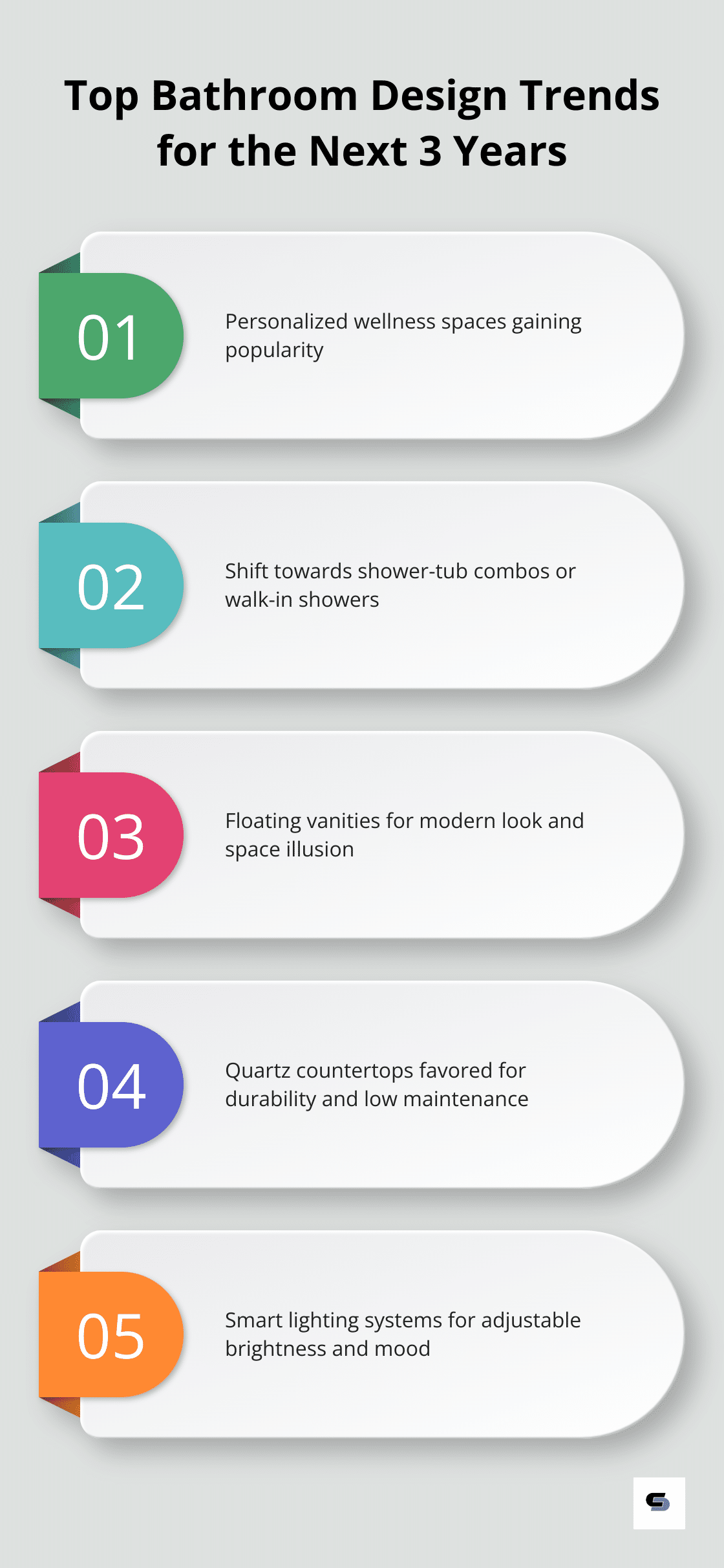
Select Fixtures and Materials
After you establish your style direction, choose fixtures and materials. Focus on quality and durability – these elements will see daily use for years to come. Porcelain tiles, for example, excel for bathroom floors due to their water resistance and longevity.
When selecting a bathtub, consider your space and usage. Recent trends show a shift towards personalized wellness spaces in home design, influencing the debate over shower vs. tub conversions. However, if space limits you, a shower-tub combo or a walk-in shower might prove more practical.
For vanities, think about storage needs and counter space. Floating vanities create a modern look and the illusion of more floor space. Quartz countertops gain favor for their durability and low maintenance requirements.
Maximize Space and Storage
Efficient layout and storage solutions play a key role in bathroom design. Use every inch wisely, especially in smaller bathrooms. Install a corner sink to free up floor space or opt for a wall-mounted toilet to create a more open feel.
Storage (often overlooked but essential for a clutter-free bathroom) can significantly increase capacity without sacrificing style. Built-in niches in shower walls, medicine cabinets, and under-sink organizers all contribute to a well-organized space.
Illuminate Your Space
Lighting plays a vital role in bathroom functionality and ambiance. Layer your lighting for the best effect. Start with ambient lighting for overall illumination, add task lighting around the mirror for grooming, and consider accent lighting to highlight architectural features or create a spa-like atmosphere.
LED lighting has become increasingly popular due to its energy efficiency and longevity. Smart lighting systems allow you to adjust brightness and color temperature, enhancing both functionality and mood.
Ensure Proper Ventilation
Don’t underestimate the importance of good ventilation. Proper airflow prevents moisture buildup, which can lead to mold and mildew issues. The Home Ventilating Institute recommends a fan that can change the air in your bathroom 8 times per hour. For a typical 100-square-foot bathroom, that translates to a 50-CFM fan.
Try a humidity-sensing fan that automatically turns on when moisture levels rise. This ensures your bathroom stays dry and fresh without you having to remember to flip a switch.
A well-designed bathroom can significantly increase your home’s value. With these elements carefully considered, you’re ready to move on to the next crucial step: budgeting and timeline planning for your bathroom transformation.
How Much Will Your Bathroom Remodel Cost?
Estimate Your Expenses
Remodeling a small bathroom averages about $6,500, but this project can range anywhere from $1,500 to $15,000. Your specific costs will depend on factors like room size, materials chosen, and labor rates in your area.
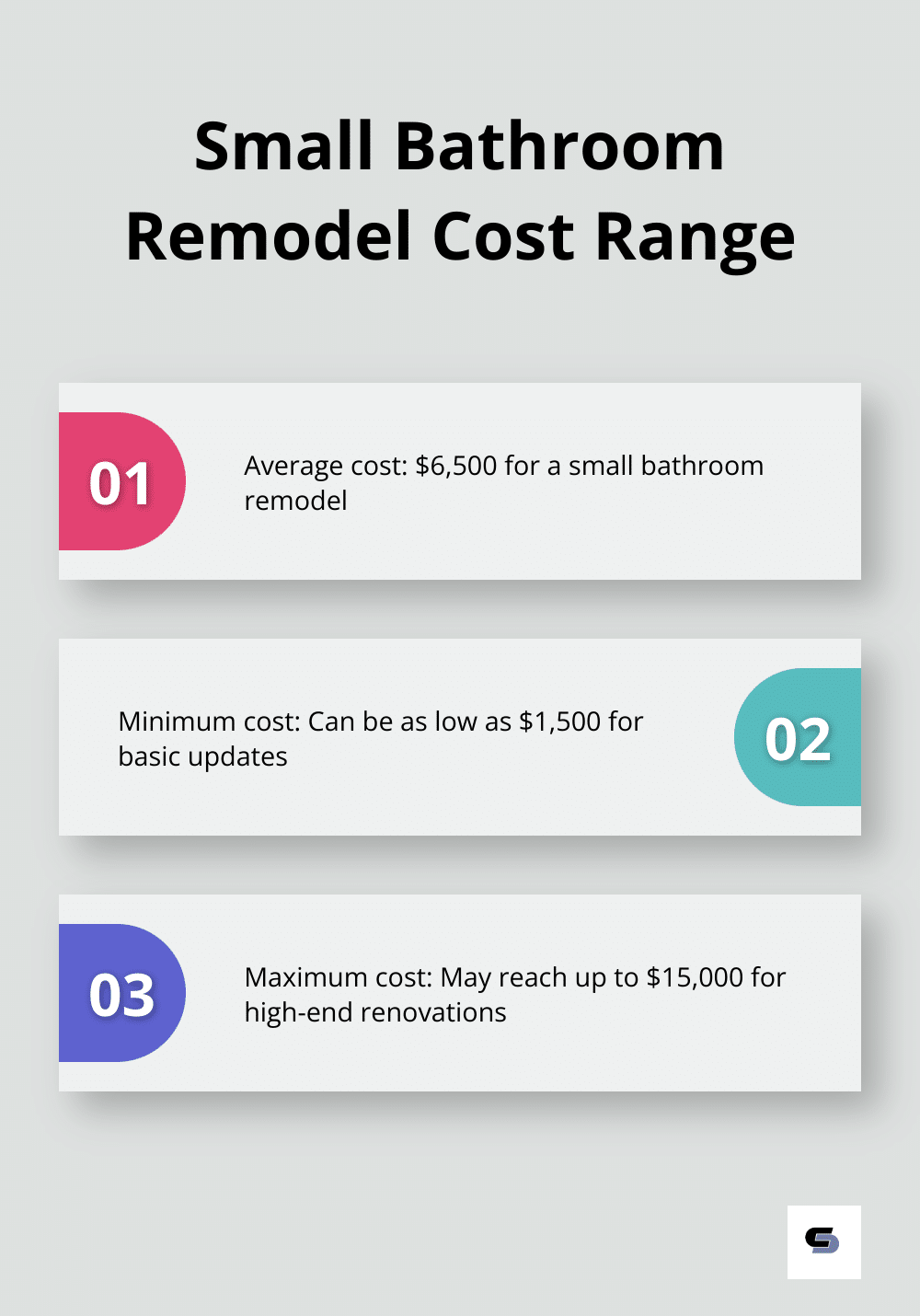
Create a list of every item you want in your new bathroom, from tiles to towel racks. Research prices for each element, including both budget-friendly and high-end options. This gives you a range to work with and helps identify where you might splurge or save.
According to recent data, you can spend anywhere from $8000 to $35000 or more on a bathroom renovation, depending on the size of your bathroom and how much your materials cost.
Set a Realistic Budget
After you have a rough estimate, add 10-20% for unexpected expenses. This buffer can cover hidden issues (like water damage or outdated wiring) that often surface during renovations.
Prioritize your must-haves and nice-to-haves. If your dream features exceed your budget, consider phasing your remodel or finding cost-effective alternatives. A prefabricated shower unit can save thousands compared to a custom tile shower.
Plan Your Timeline
A typical bathroom remodel takes 4-6 weeks, but complex projects can stretch to 3 months or more. Create a detailed timeline with your contractor, breaking down each phase of the project.
Account for lead times on custom items like vanities or specialty tiles. These can take weeks or even months to arrive, so order early to avoid delays.
Prepare for some disruption to your daily routine. If you have multiple bathrooms, schedule the remodel for your least-used one first. This minimizes inconvenience and allows you to test design choices before tackling your main bathroom.
Consider Financing Options
Explore various financing options for your bathroom remodel. These might include home equity loans, personal loans, or credit cards with promotional interest rates. Each option has its pros and cons, so research thoroughly to find the best fit for your financial situation.
Factor in Long-Term Savings
While upfront costs are important, also consider long-term savings. Energy-efficient fixtures and water-saving toilets can reduce utility bills over time. High-quality materials might cost more initially but can save money on repairs and replacements in the future.
Final Thoughts
A bathroom remodel planner transforms your daily life and increases your home’s value. This roadmap guides you through each step, from assessing your current space to designing your dream bathroom. A thoughtfully designed bathroom enhances your comfort and provides a personal sanctuary where you can relax and rejuvenate.
Your remodel should focus on creating a functional, efficient space that meets your needs now and in the future. Energy-efficient fixtures, proper ventilation, and smart storage solutions contribute to a bathroom that works for you long after the renovation completes. These elements ensure your new bathroom remains a space you’ll love for years to come.
At Cameron Construction, we specialize in turning bathroom renovation dreams into reality. Our team of experts can help you navigate every aspect of your project, from initial design to final installation. Take the time to plan carefully, consider all your options, and envision the possibilities for your new bathroom.

